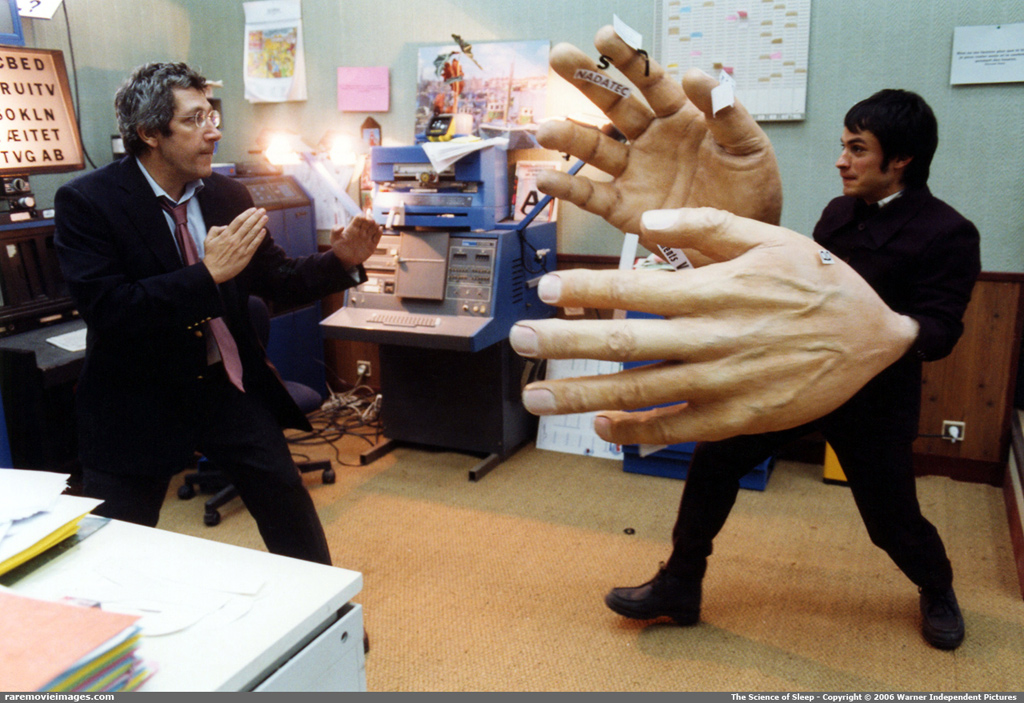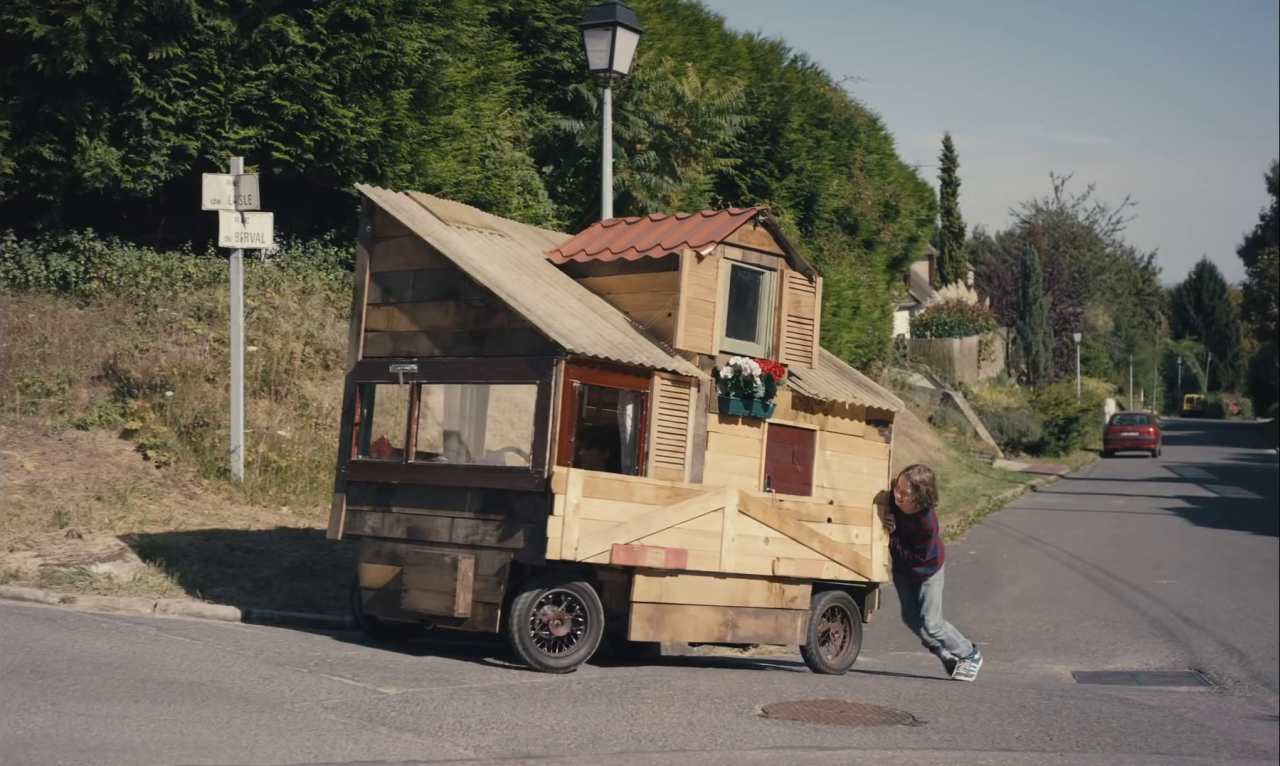Is “Microbe and Gasoline” less surreal than Michel Gondry’s other films?
French director Michel Gondry is known for his whimsical use of artistic flourishes like stop-motion and in-camera special effects, as well as, narratively, his tendency to playfully rearrange reality. His newest film Microbe and Gasoline (2015) eschews the on-the-surface surrealist elements that we’ve come to expect from Gondry after Eternal Sunshine of the Spotless Mind (2004), The Science of Sleep (2007), and Be Kind Rewind (2008), but it is no less a celebration of childlike imagination and creative daring.

Microbe and Gasoline follows the friendship and adventures of two young boys, budding artist Daniel (Ange Dargent) and mechanical genius Théo (Théophile Baquet), as they escape their bullies through building engines and drive across France in a home-made car that looks like a house. At the New York Film Festival 2015, Gondry confirmed that the film’s events (minus the road trip) come from Gondry’s childhood, many recreated faithfully down to the details.
Notably, in documenting this period of his life, Gondry has, for the most part, adopted a more “objective” visual style and tone than is evident in his past films. Microbe and Gasoline has almost no surreal sequences, animation, or artistic effects in the frame itself. Rather than allowing Daniel’s drawings to leap off his page and bring us inside the young boy’s visions, Gondry tells his Self-Portrait of the Artist as a Young Man from an external perspective—what in novelistic form would be third-person singular narration. We witness Daniel’s early artistic attempts and adolescent trials, but we see him as the world sees him. They call him “Microbe”; they mistake him for a girl due to his long hair; only one person (Théo) comes to his first gallery show (another event from Gondry’s life). It is interesting that Gondry examines the young artist from the outside rather than from within the boy’s own mind. That said, we still view him through the older artist’s personal recollections (and how Gondry imagines the world saw him as a boy), so the externality and objectivity are ultimately illusions.
In addition to its lack of effects, Microbe is shot mostly in medium-wide shots on an unvarying lens to establish the sense of objectivity. At NYFF, Gondry noted that, in the cinematography, he took inspiration from Robert Besson, whose training was “very square, always [using] the same lens.” More close-ups or ultra-wide shots would have heightened the sense of individual perspective and subjective views. Gondry also watched some other road movies or coming-of-age movies for self-instruction, including My Little Loves (1974), “American movies from the 50s” like The Little Fugitive (1953), and “of course” The 400 Blows (1959), but primarily, he drew from the imagery in his head: “I really thought of my memories. I tried to be as honest as possible. My previous movies have a lot of art effects, and this one, except that they build the car that looks like a house, the way of shooting it was very straightforward.”
There are two notable surreal additions to the film: first, of course, the building of the car/house, which the boys drive across France; and second, a sequence near the end of the film wherein Daniel and Théo fly home after their car has been destroyed. Daniel wakes up mid-flight and notes with horror that all the other passengers are fast asleep, while the plane is flying backward. Gondry confirmed that this dream of Daniel’s was also his own: “It’s a dream I drew at the time. I didn’t want to show too many dreams in this movie, but it felt that coming back home, they were coming back to the starting point in a way. Daniel starts to doubt about the reality of the trip and question everything, so it’s a little bit disjointed from reality.” As they shift from their home-made car to the plane and then the train, Daniel is disoriented; perhaps the car, as a symbol of boyhood daring, is the healthy way to travel, while these worldly commercial means of transport are too frightening and overwhelming for the youth. In any case, the surreal airplane sequence makes us, as Daniel does, question the reality of the whole trip—perhaps rightly so, since Gondry has identified the trip as a fantasy that did not occur, unlike the earlier events which are based in reality.
Despite these departures, the third-person look and feel of Microbe marks an interesting moment in his career. While Gondry has used plenty of autobiography before, this is one of his least surreal or stylized films. Brooklyn Magazine writes that “this may be the most grounded fiction film Gondry has ever made. If anything, it errs on the side of downbeat realism.” Still, Gondry’s trademark inventiveness, quirks, and melancholy are as present as ever. The most pleasing outcome of the film’s mix of realism and understated fantasy (especially as we watch the house-car travel through a realistically depicted world) is an abundance of humor. The road trip is the highlight of the film, producing comedy for the audience and letting us vicariously ride along as the boys achieve their big adventure. For all its apparent narrative distance, Microbe clearly values creation and boldness above a mindset lodged in the social, official or externally given world.

In one scene, Daniel takes second prize in a drawing contest, losing out because, while he shows the most technical skill, he is unimaginative in his choice of subject (he draws the prize he hopes to win, a toy airplane). Gondry said, “That again was a truth that happened to me. I was perhaps nine—I was with my family, and we went to this little town. There was a drawing competition going on. First prize, we [would] win this car, and in my childish mind, to get this car you have to draw the car.” The first-prize winner is a young girl who, with little skill, has drawn a more creative picture. By including this episode, Gondry affirms his belief that we must summon new, greater realities from the depths of our own minds than those that exist before our eyes.
The film ends on a down note: Théo is forced to move away and live with his brother after the death of his mom, and Daniel acts out by fighting in school, missing his friend and never learning that his former crush Laura now likes him. Yet Microbe and Gasoline leaves us with an overriding sense of delight and wonder at the brave spirit the boys show in taking their journey—a journey we wish we’d taken and still hope, somehow, to experience. Thus Microbe’s un-reality, in being more limited and contained, results in a more moving and relatable story than some of Gondry’s overtly surrealist streaks.

